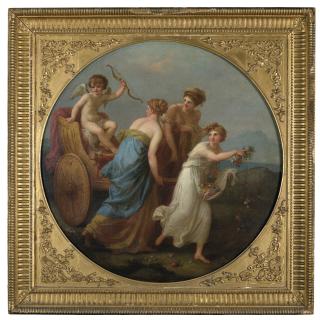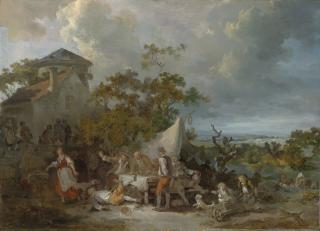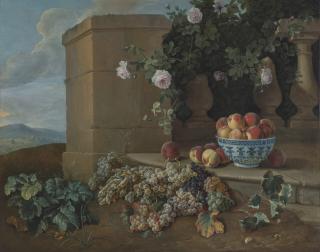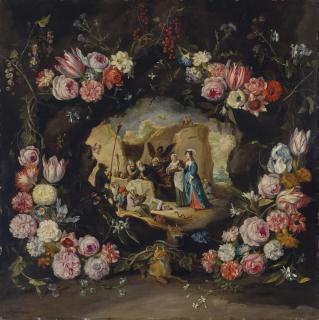Andrea Soldi
Portrait D'Un Marchand De La Levant Company, De Trois-Quarts
Found at
Christies,
New York
Maîtres Anciens : Peintures - Sculptures - Dessins, Lot 28
15. NOV - 15. NOV 2023
Maîtres Anciens : Peintures - Sculptures - Dessins, Lot 28
15. NOV - 15. NOV 2023
Estimate: 20.000 - 30.000 EUR
Price realised: 21.420 EUR
Price realised: 21.420 EUR
Description
ANDREA SOLDI, PORTRAIT OF A MERCHANT OF THE LEVANT COMPANY, THREE-QUARTER LENGTH, SIGNED AND DATED, OIL ON PAPER LAID DOWN ON CANVAS, IN A FEIGNED OVAL
This delicate small-scale portrait of a member of the British Levant Company was painted by the Florentine artist Andrea Soldi during his time in Syria and the Levant, between 1733 and 1735, prior to his arrival in England in circa 1736. Although the sitter’s identity remains a mystery, a large-scale portrait of the same gentleman seated on a Turkish carpet beneath a tree is also known, sold Christie’s London, 4 July 2019, lot 41 (fig. 1).
The only source for information on Soldi’s early career before his arrival in London is the notebooks of the antiquarian George Vertue, who commented: 'From his own Country [Italy, Soldi] set out to the Holyland [sic.] which he had great desire to see, on his way there or back at Aleppo he became acquainted with some English Merchants whose pictures having drawn with much approbation they advised him to come to England' (G. Vertue, Notebooks 3, c. 1742, p. 109). Relatively few of Soldi's portraits of this rich, powerful and privileged merchant class are recorded. John Ingamells, in his checklist of Soldi's works in the Walpole Society (XLVII, 1980), lists only three portraits from the artist's Aleppan period.
Founded by Royal Charter in 1581, the English Levant Company had a monopoly over trade between England and the Ottoman Empire, the term Levant then meaning all of the countries along the Eastern Mediterranean shores. Run by a Court of Governors in London and represented by the English Ambassador in Constantinople, its chief trading post was Syria’s ancient trading capital of Aleppo. The city commanded the great trans-desert trading routes between East and West: English woollen broadcloth, tin and lead were bartered chiefly for silk from Antioch, Tripoli, Beirut and most desirably, Persia, as well as spices, coffee, carpets, mohair yarn and other exotic merchandise. Aleppo, with its high citadel, domes and minarets, must have presented an exciting prospect. The English lived within the Khan al-Gumruk, which was situated on the main thoroughfare of the covered, labyrinth-like souk in the heart of the city.
The English merchant in this portrait is shown in Turkish costume, wearing a turban and a blue, fur-lined kurk over a white shirt. In her thesis on Soldi’s Levantine Portraits, Sarah Moulden explained that the merchants’ presentation and style of dress was as much a business strategy as a statement of social intent, since the adoption of local Turkish dress enabled the merchant to integrate with the community in which he sought to live and do business (S.E. Moulden, 'Turning Turk': The negotiable self in Andrea Soldi's Levantine Portraits, c. 1730-33, MA dissertation, Courtauld Institute of Art, London, 2007).
After successful completion of their tenure in the Levant, the merchants would return to London to take up prestigious posts within the Company. It was an established convention for a merchant to have his portrait painted immediately before returning home, therefore preserving for posterity his identity as a ‘Turkish merchant’. Soldi’s portraits so impressed the merchants that they encouraged him to travel to England where his talents set him apart from the old and middle-aged guard of native portrait painters and secured him immediate success as a society portrait painter.
- Vente anonyme, Antik A.Ş., Istanbul, 14 mai 2016, lot 48. | Collection particulière.
This delicate small-scale portrait of a member of the British Levant Company was painted by the Florentine artist Andrea Soldi during his time in Syria and the Levant, between 1733 and 1735, prior to his arrival in England in circa 1736. Although the sitter’s identity remains a mystery, a large-scale portrait of the same gentleman seated on a Turkish carpet beneath a tree is also known, sold Christie’s London, 4 July 2019, lot 41 (fig. 1).
The only source for information on Soldi’s early career before his arrival in London is the notebooks of the antiquarian George Vertue, who commented: 'From his own Country [Italy, Soldi] set out to the Holyland [sic.] which he had great desire to see, on his way there or back at Aleppo he became acquainted with some English Merchants whose pictures having drawn with much approbation they advised him to come to England' (G. Vertue, Notebooks 3, c. 1742, p. 109). Relatively few of Soldi's portraits of this rich, powerful and privileged merchant class are recorded. John Ingamells, in his checklist of Soldi's works in the Walpole Society (XLVII, 1980), lists only three portraits from the artist's Aleppan period.
Founded by Royal Charter in 1581, the English Levant Company had a monopoly over trade between England and the Ottoman Empire, the term Levant then meaning all of the countries along the Eastern Mediterranean shores. Run by a Court of Governors in London and represented by the English Ambassador in Constantinople, its chief trading post was Syria’s ancient trading capital of Aleppo. The city commanded the great trans-desert trading routes between East and West: English woollen broadcloth, tin and lead were bartered chiefly for silk from Antioch, Tripoli, Beirut and most desirably, Persia, as well as spices, coffee, carpets, mohair yarn and other exotic merchandise. Aleppo, with its high citadel, domes and minarets, must have presented an exciting prospect. The English lived within the Khan al-Gumruk, which was situated on the main thoroughfare of the covered, labyrinth-like souk in the heart of the city.
The English merchant in this portrait is shown in Turkish costume, wearing a turban and a blue, fur-lined kurk over a white shirt. In her thesis on Soldi’s Levantine Portraits, Sarah Moulden explained that the merchants’ presentation and style of dress was as much a business strategy as a statement of social intent, since the adoption of local Turkish dress enabled the merchant to integrate with the community in which he sought to live and do business (S.E. Moulden, 'Turning Turk': The negotiable self in Andrea Soldi's Levantine Portraits, c. 1730-33, MA dissertation, Courtauld Institute of Art, London, 2007).
After successful completion of their tenure in the Levant, the merchants would return to London to take up prestigious posts within the Company. It was an established convention for a merchant to have his portrait painted immediately before returning home, therefore preserving for posterity his identity as a ‘Turkish merchant’. Soldi’s portraits so impressed the merchants that they encouraged him to travel to England where his talents set him apart from the old and middle-aged guard of native portrait painters and secured him immediate success as a society portrait painter.
- Vente anonyme, Antik A.Ş., Istanbul, 14 mai 2016, lot 48. | Collection particulière.
Auction result well in line with expectations
The work Portrait D'Un Marchand De La Levant Company, De Trois-Quarts by Andrea Soldi was sold in the Maîtres Anciens : Peintures - Sculptures - Dessins auction at Christies in New York in November this year. The estimated price for the artwork was previously given by the auction house with a range of EUR 20,000.00 – 30,000.00, the actual price achieved of EUR 21,420.00 could thus just exceed the lower estimate. Of course, this price has nothing to do with the top prices that other works by Andrea Soldi achieve. The highest price we have observed so far was reached by the work Portrait of a gentleman, possibly Richard Salwey, half-length, in a fur-trimmed red coat and a turban, leaning on a plinth in December 2011 with an auction result of GBP 825,250.00 (€ 988,353.45).
Auktionsergebnis im Rahmen der Erwartungen
Die Arbeit Portrait D'Un Marchand De La Levant Company, De Trois-Quarts von Andrea Soldi wurde im November diesen Jahres in der Auktion Maîtres Anciens : Peintures - Sculptures - Dessins bei Christies in New York versteigert. Der Schätzpreis für das Kunstwerk wurde von dem Auktionshaus zuvor mit einer Spanne von EUR 20.000,00 – 30.000,00 angegeben, der tatsächlich erzielte Preis von EUR 21.420,00 konnte den unteren Schätzpreis somit knapp übertreffen. Dieser Preis hat freilich nichts mit den Spitzenpreisen zu tun, die andere Arbeiten von Andrea Soldi erzielen. Den höchsten von uns bisher beobachteten Preis erreichte die Arbeit Portrait of a gentleman, possibly Richard Salwey, half-length, in a fur-trimmed red coat and a turban, leaning on a plinth im Dezember 2011 mit einem Auktionsergebnis von GBP 825.250,00 (€ 988.353,45).


























